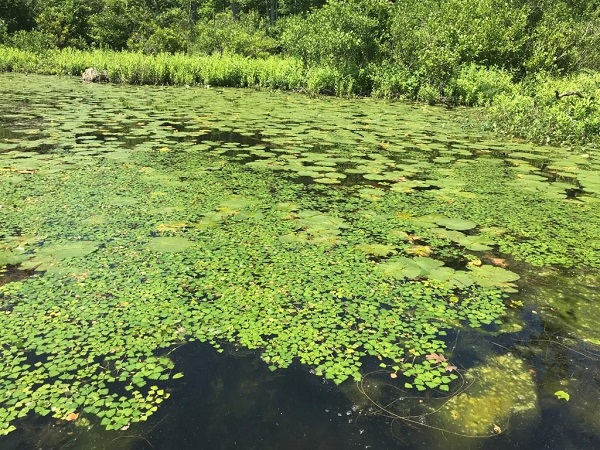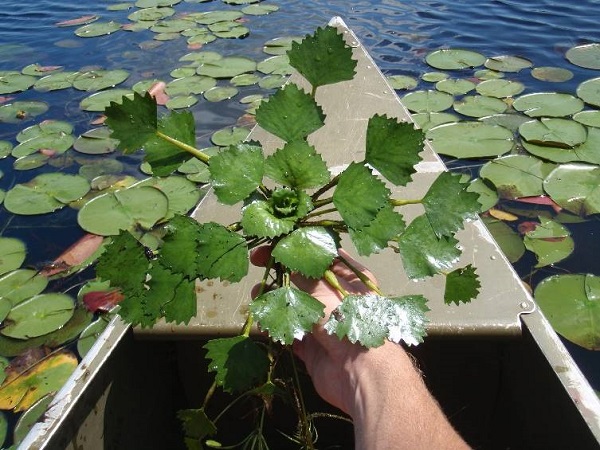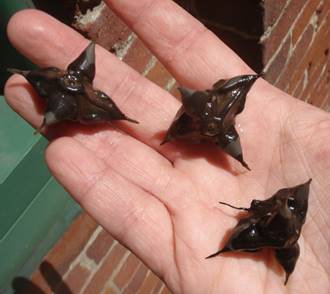DEM MONITORING LAKES AND PONDS ACROSS RHODE ISLAND FOR INVASIVE AQUATIC SPECIES

Public being asked to take a photo and report suspected new findings of water chestnut plants to DEM
PROVIDENCE, R.I. – The Rhode Island Department of Environmental Management (DEM) is surveying lakes, ponds, and rivers across the state this summer as part of an annual monitoring program to identify aquatic invasive species. During a routine survey on June 12 in Barney Pond in Lincoln, DEM staff observed and removed several small water chestnut plants that were scattered throughout the pond. As water chestnut had not been previously documented in Barney Pond or its watershed, DEM notified the Town of Lincoln and searched for the source of the invasive plants. Staff surveyed Olney Pond in Lincoln Woods State Park, which is located upstream from Barney Pond, and found a large patch of water chestnut plants. The plants, which have likely been in the pond for at least a year, dropped seeds that floated down to Barney Pond and started new plants. In July, staff from DEM’s Office of Water Resources, in coordination with DEM Parks, removed the invasive plants as part of conservation efforts to manage and protect Olney Pond’s habitat from this non-native species.
Water chestnut is a rooted aquatic plant that forms dense, floating mats that cover the surface of the water, limiting light to other aquatic plants and quickly displacing native species and decreasing biodiversity. These dense mats may impede recreation such as boating, fishing and swimming, and lower the dissolved oxygen in the water, creating the potential for fish kills. Large and woody fruits containing four sharp barbs appear on the plants by late summer and are released as the water chestnut plants die off with the onset of frost. As the barbed fruits wash up along the shoreline, they pose a hazard for humans and pets.

Water chestnut was introduced to New England from Asia as an ornamental plant that spread into natural waterbodies. It was first observed in Rhode Island in 2007 in Belleville Pond in North Kingstown. Once introduced into a water body, water chestnut establishes and spreads rapidly. As of November 2017, the invasive plant has been documented in eight RI lakes or ponds; they include Valley Falls Pond in Central Falls; Central Pond and Turner Reservoir in East Providence; Porters Pond in Foster; Solitude Springs Farm Ponds in Hopkinton; Belleville Ponds in North Kingstown; Chapman Pond in Westerly; and Sylvestre Pond in Woonsocket. If you think you have spotted the plant or seed in a new location, please take a picture and report it to DEM at DEM.WaterResources@dem.ri.gov.

“It is much easier and cost effective to remove a small patch of water chestnut than manage an entire lake covered with plants, so early detection is key,” said Katie DeGoosh-DiMarzio, Environmental Analyst with DEM’s Office of Water Resources.
“Public awareness of invasive plants is the most effective way to combat the spread of aquatic invasive species from one lake to another by preventing the inadvertent transport of a hitch-hiking plant fragment. Many of the aquatic invasive plants in Rhode Island can reproduce from just one small plant fragment and do not need entire root systems to successfully establish in a new spot.
Cleaning off every bit of plant from recreational gear used at one pond is essential before visiting another—this includes boats, kayaks, canoes, motors, trailers, paddles, jet skis, fishing gear, waders, water tubes, and anchors.”
Water chestnut management costs in Lake Champlain and other Vermont waters exceeded $400,000 in 2009 and have totaled over $10 million since 1982. The costs to treat a 1.3-mile stretch of the Sudbury River in Massachusetts were $60,000 in 2017; however, the river needs continual treatment and surveillance as water chestnut seeds can lie dormant for up to 12 years.
Water chestnut is just one of the aggressive, invasive species found in RI waters, according to a report by DEM’s Office of Water Resources. Earlier this month, DEM volunteers removed lotus leaves from a large, non-native lotus patch that was found in Meshanticut Pond in Cranston.
DEM believes that an area resident – unaware that planting in a pond is not allowed and of the plant’s noxious nature of rapidly spreading – released the lotus in the pond. Aerial photographs indicate that it is reproducing at an exponential rate.
The patch currently covers 1.25 acres of the 12-acre pond, with its massive leaves covering large areas and outcompeting native aquatic vegetation. It is urgent that the growth of this invasive species is culled, and the population managed, so it does not spread to other areas in the state or New England. Invasive species have contributed to the decline of 42% of US endangered and threatened species, and for 18% of such species, invasives are the main cause of their decline, according to the United States Forest Service.
For more information on DEM programs and initiatives, visit http://www.dem.ri.gov/. Follow us on Facebook at www.facebook.com/RhodeIslandDEM or on Twitter (@RhodeIslandDEM) for timely updates.
